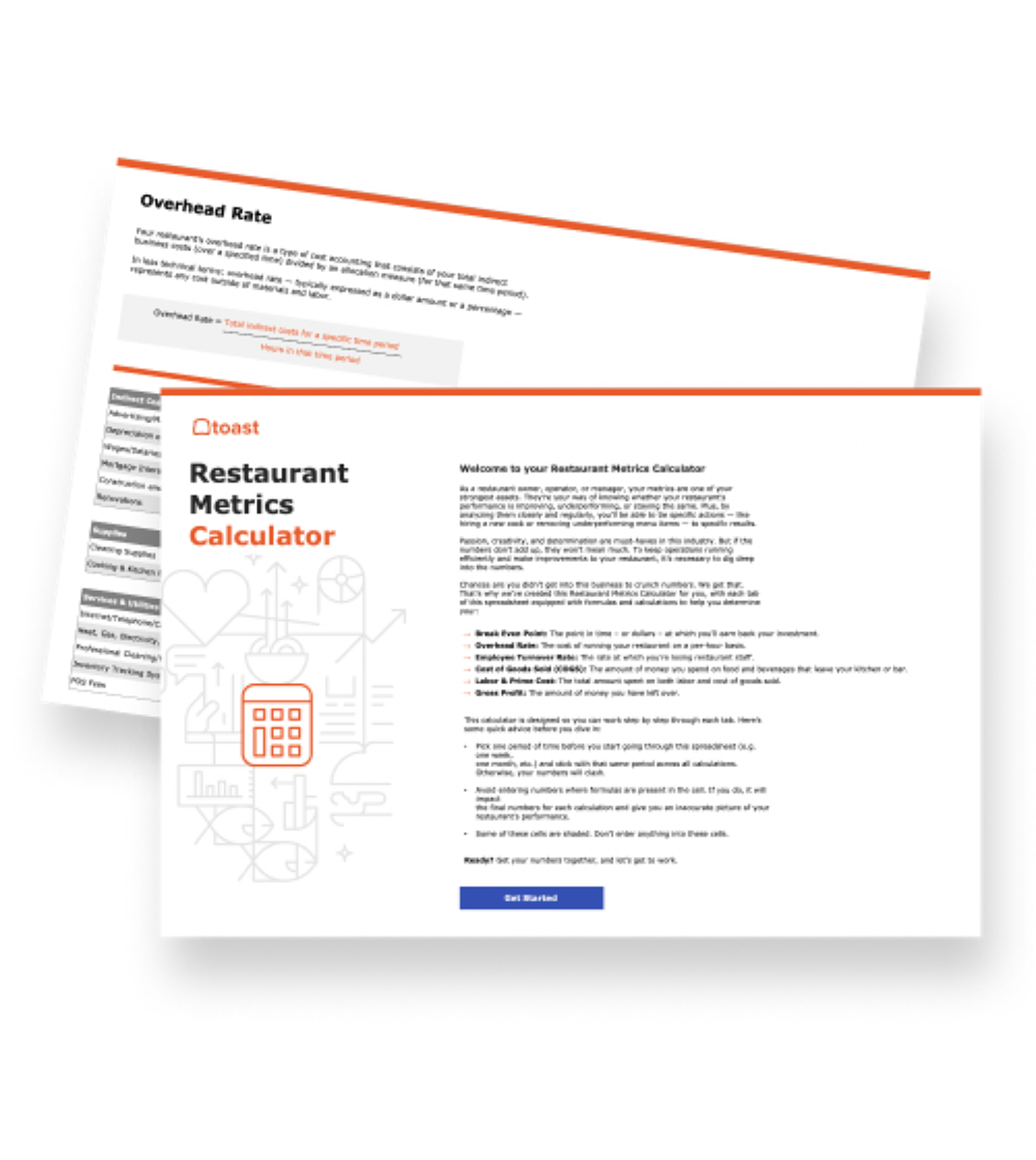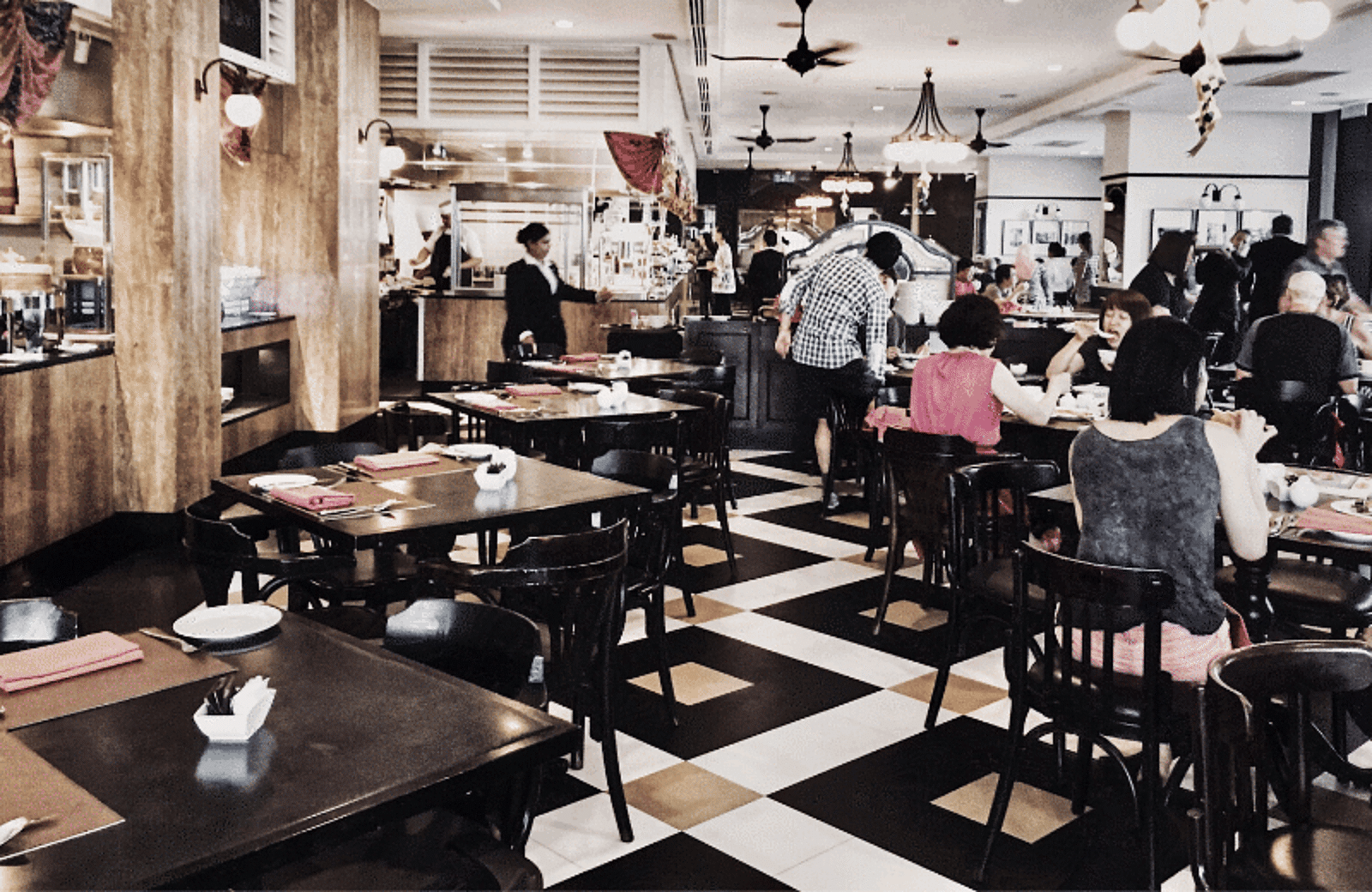
7 Critical Restaurant Benchmarks
Here are the 7 most important restaurant benchmarks your restaurant should consider analyzing and how you can exceed them.

Tessa ZuluagaAuthor


Restaurant Metrics Calculator
Use this free calculator to calculate the key restaurant metrics needed to understand the health and success of your business.
Get free downloadIn order to understand how well any business is performing there are key metrics that need to be analyzed, and a restaurant business is no exception.
Having a firm grip on what is going on in the industry is essential to your success. It’s vital to stay up to date with the current state of restaurant sales. Benchmarking is the process of comparing your business to industry averages. This is crucial for making decisions about all restaurant operations. The concept of benchmarks is not new, however as restaurant technology has advanced, so have benchmarks. Today, the data restaurant owners have at their fingertips gives them the capability to track so much more.
There are 3 types of restaurant benchmarking: front-of-house, back-of-house, and general operations.
Read on to learn about the most important restaurant benchmarks and industry averages, why your operation needs to track them, and how to set yourself up to exceed industry averages.
Front-of-house restaurant benchmarks focus on guests and revenue
Your front-of-house benchmarks include anything guest-related — total sales, sales per table, table turns, ticket/basket sizes, and more. Basically, anything that includes your dining room, bar, and waiting areas have benchmarks you can and should track.
Your front-of-house benchmarks measure how well you move guests through your restaurant and maximize their value. Examples of front-of-house benchmarks include:
Revenue per seat
Table turnover rate
Back-of-house restaurant benchmarks focus on the efficiency of your kitchen
Back-of-house benchmarks refer to kitchen, prep, and inventory metrics.
These measure how your kitchen dishes out profits compared to the rest of the industry. Back-of-house benchmarks include:
Food cost percentage
Inventory turnover ratio
General operation restaurant benchmarks reflect your overall success
Front-of-house and back-of-house restaurant benchmarks offer a micro perspective on the health of individual restaurant components. General operational benchmarks put it all together to provide a holistic, macro view of your restaurant’s health.
General operation benchmarks are big picture, measuring your restaurant as a whole. Examples of general operation benchmarks include
Prime cost
Profit Margin
Sales per square foot
7 most critical restaurant benchmarks
Here are the 7 most critical restaurant benchmarks you need for FOH, BOH, and general operations.
1. Prime Costs ~ 55% or less
Prime costs are your total cost of labor plus your cost of goods sold (COGS).
Tracking restaurant prime costs can help you successfully balance increasing sales and decreasing costs. Increasing prices may seem like an obvious solution, but it’s equally important to decrease costs.
Divide your prime costs by your gross sales to get your prime cost as a percentage of sales.
Restaurants typically target about a 60% prime cost rate — though recently this number has shifted to 55% or lower. It’s important to note that this number will shift throughout the year as seasons change.
You should constantly be working to lower it. Setting a target using SMART goals (specific, measurable, attainable, relevant) can help you lower your prime cost. Once you have a set goal, start tracking your COGS and labor costs regularly to stay informed and take action whenever possible.
Monthly tracking is fine. Weekly is better. Real-time tracking is best, and it’s obtainable via restaurant-specific invoice automation.
Once you find what needs to be fixed, redesign your menu accordingly to take advantage of high-impact, effective items with lower COGS. This way, by lowering your prime cost regularly, you can stay ahead of inflation while increasing your profit.
Restaurant Cost Control Guide
Use this guide to learn more about your restaurant costs, how to track them, and steps you can take to help maximize your profitability.

2. Profit Margin ~3-5%
How much money is your restaurant actually making? It’s essential to know where your restaurant stands. Your profit margin refers to the amount of profit expressed as a percentage of annual sales. Sales - costs = profit and it’s all about profit in order to run a successful restaurant in 2023. The range for restaurant profit margins typically spans anywhere from 0 – 15 percent, but the average restaurant profit margin usually falls between 3 – 5 percent. To accurately calculate profit margin use this formula:
Net profit margin = Revenue – All costs / Revenue
Or use this free Restaurant Profit Margin Calculator to help consistently capture and track your profit margin.
Restaurant Profit Margin Calculator
Use this free Restaurant Profit Margin Calculator to see how efficiently you turn sales dollars into profits.

3. Revenue per seat ~$27 per seat
You set up your floor plan in a way to seat as many guests as possible while staying under capacity and running steps of service efficiently. For every seat that is filled in your restaurant, your business is making a certain amount of revenue. Your restaurant concept will affect your revenue per seat because your cuisine type, location, and prices will influence this number. The industry average in 2022 per seat is about $27 a seat, but this number has a massive range and is truly specific to your restaurant. Understanding the cost of each seat in your restaurant will help you know how well your business is performing. Revenue per seat in a day can be calculated through this equation:
(Total Revenue ÷ Seat Hours)
Seat hours can be calculated by:
(Total number of seats x hours you’re open)
Once you have this number calculated you can work towards increasing it. If you can consistently raise your revenue per seat, you will consistently increase your profits. In order to do this, apply effective menu engineering, incorporate specials/promotions, and focus on turning tables. Menu engineering doesn’t mean just increasing prices on popular dishes, it also means working with your staff to upsell items and make recommendations. Another reason your revenue per seat may be low is it your seats aren’t consistently filled. Make your restaurant more appealing by offering specials and promotions. Lastly, work with your staff to turn tables more often and in a more functional way. This is where your host stand also comes into play, as it’s crucial they plan ahead and seat tables in order to maximize the amount of guests seated.
Menu Engineering Worksheet
Use this menu engineering worksheet, complete with intricate menu engineering formulas, to determine areas of strength and weakness in your restaurant's menu.

4. Table turnover rate ~3 turns per service
Speaking of turning tables, table turnover rate is another front-of-house benchmark you need to track. This refers to how often guests occupy a table during a measured period of time. The average restaurant in a single dinner service turns a table about 3 times. This one is peculiar because slow a table turnover rate isn’t necessarily a negative thing. Guests voluntarily staying at your restaurant for long periods is a great sign that they are enjoying their experience. However, once they stop ordering more food and drinks they become “campers”, guests who linger, taking away the opportunity to sit a new guest. This has been a bigger issue in recent years as guests tend to hang out longer to sit on their smartphones. This benchmark is all about finding that happy medium where guests have a high-quality experience without taking up the table for too long.
To nail that happy medium rate make sure your host isn’t seating incomplete parties; this adds time to a table that isn’t ready to be sat yet. Also, training your wait staff to guide tables to order at a reasonable pace will help. Lastly, don’t be afraid to kindly drop the check after asking if there’s anything else you can get them.
5. Food cost percentage ~28-35%
The business of dazzling customers while minimizing costs is not an easy one. However, staying on top of your food cost percentage is vital to every restaurant business. The combination of understanding food cost formulas and the application of technology to take control of these costs will ensure the optimization of your ingredient purchases. You can calculate your food cost percentage by diving your total food costs by the total food sales in a given period of time. Typically, a decent food cost percentage is about 28-35%. Of course, every restaurant is different, and finding the best, ideal percentage for your business is crucial to make a profit. Here's how to calculate the ideal food cost percentage for your restaurant:
Ideal Food Cost Percentage = Total Cost Per Dish ÷ Total Sales Per Dish
However, this process can be simplified through cost tracking tools.
6. Inventory turnover ratio ~5
Another tedious game is purchasing enough, but not too much inventory to supply your restaurant’s needs. This benchmark is important because it’s easy to accidentally spend way too much money on unnecessary inventory. Understanding how much inventory to order is something that constantly needs to be kept as demand shifts throughout the year. The more times the inventory turns over during a given period, the healthier the business.
Here’s how to calculate your inventory turnover ratio:
Calculate average inventory for the time period
(Beginning inventory + Ending inventory) ÷ 2 = Average inventory
Calculate inventory turnover ratio
Inventory turnover ratio = Cost of goods sold ÷ Average inventory
The average industry rate is around 5, however once again you need to consider what is best for your specific restaurant and actively work to improve that number. Some ways to execute this are by predicting sales based on the history of your restaurant, staying informed about inflation, and considering different suppliers. For example, if you run a restaurant in a cold state maybe you can predict that you’ll need to order slightly more takeout boxes in December vs June based on takeout/delivery sales from previous years. Staying up to date with inflation enables you to stay on top of inventory costs and allows you to increase menu prices if necessary. Lastly, being informed about inflation also enables you to research other possible suppliers that you may be able to strike a deal with to save money.
7. Sales per square foot
Lastly, calculating your sales per square foot can help you predict how successful your restaurant may be. This is a measurement of how efficient your restaurant operations are considering the amount of space you own. Here’s how to calculate your restaurant sales per square foot:
(Annual sales) ÷ (total square feet of restaurant) = sales per square foot
For full-service restaurants, your target number is at least $150 per square foot. On the other hand, limited-service restaurants should typically be making at least $200 per square foot. And lastly, fast casual restaurants should try to be targeting a way higher number up to about $500 per square foot. This is because fast-casual restaurants tend to be smaller in size and overhead cost but high in foot traffic. To optimize your sales per square foot consider modern steps of service.
Level up your restaurant operations
Analyzing these essential restaurant benchmarks will enable you to increase profits. While obtaining these metrics it’s important to also make use of today’s best marketing practices and relevant industry trends. You can also start taking control of your bottom line by transforming invoices into insights with xtraChef by Toast. Your restaurant has endless potential to be better. Start improving your restaurant operations today.
Related Restaurant Resources:
Is this article helpful?
DISCLAIMER: This information is provided for general informational purposes only, and publication does not constitute an endorsement. Toast does not warrant the accuracy or completeness of any information, text, graphics, links, or other items contained within this content. Toast does not guarantee you will achieve any specific results if you follow any advice herein. It may be advisable for you to consult with a professional such as a lawyer, accountant, or business advisor for advice specific to your situation.
Read More
Subscribe to On the Line
Sign up to get industry intel, advice, tools, and honest takes from real people tackling their restaurants’ greatest challenges.



